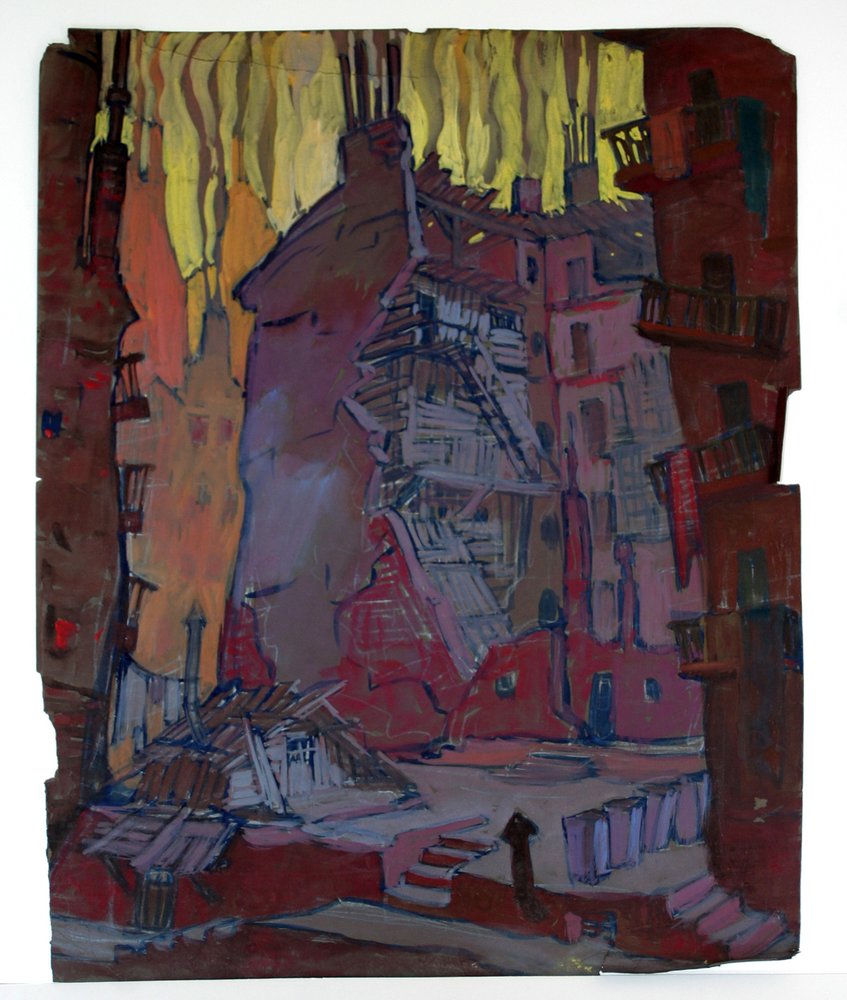Stop 10

Ruins of Hamburg; outdoor study.
| Hamburgas drupas; skicējums dabā.
Tempera, 16 in x 20.12 in (40.64 cm x
71.76 cm), 1945.
In 1945, my father escaped a forced labor camp in Pomerania and emerged from the forests of the Rhine Valley to confront the devastation of post-World War II Germany. He had found his way towards British forces and was eventually rescued by Canadian and British soldiers. In Lubeck, starved and emaciated, he was nursed back to health by British doctors and nurses to the point he could resume independent activity. As soon as he was able to leave the hospital, my father began to paint the grim aftermath of the war. In this outdoor study, he interprets the bombed-out residential neighborhoods of Hamburg. He continued to record his surroundings when he relocated to a displaced persons camp.
In His Own Words:
War and Displacement (Stops 10 – 13)
“For me the closing year of the war meant forced labor in Germany, after being conscripted by the German war system to work in the fields of Pomerania, picking potatoes, digging trenches, freezing and living at a near starvation level. This period of time was associated with constant attacks by aircraft and fleeing from the Russians.
Then, finally, the war ended and I found freedom in Lubeck. There with the assistance of the British military authorities a cabaret-style theater was formed. It was formed for the light entertainment needs of the British army at various locations and I was able to get some work there.
Together with performers from the Riga Circus, I joined up with acrobats and clowns and some notable stars from the Latvian opera and ballet to create a variety show. This is where I first met up with the conductor and composer Janis Kalnins, the ballerina Edite Pfeifere, the opera singer Teodors Brilts and others. My job was to paint small supporting sets for various numbers. For instance, when Brilts sang the Toreador Aria, my drop in the background would depict the image of an angry bull.
With ample food provided to me by the British Army, I was able to slowly regain my strength. From living in an emaciated condition, I was able to return to feeling human again.”
Viņa
paša vārdos:
Karš un bēgļu gaitas
(10. - 13. pietura)
„Kaŗa beigu posms Vācijā saistījās ar piespiestu kalpošanu vācu kaŗa sistēmai – ar kartupeļu lasīšanu Pomerānijas laukos, tranšeju rakšanu, salšanu un pusbadu. Ar lidmašīnu uzbrukumiem un nemitīgu bēgšanu no krieviem.
Tad beidzot, kara beigas un brīvībā Libekā. Tur ar angļu kaŗa iestāžu starpniecību tika organizēts viegla žanra teātris, kas kalpotu angļu armijas izklaidēšanas vajadzībām dažādās vietās. Tur arī es dabūju darbu. Kopā ar Rīgas cirkus māksliniekiem, akrobātiem, klauniem, raibā programmā līdzi darbojās arī daži mūsu ievērojami operas un baleta mākslinieki. Tur sastapos ar komponistu Jāni Kalniņu, baleta dejotāju Edīti Pfeiferi, operdziedātāju Teodoru Briltu un citiem. Mans uzdevums bija gleznot dekoratīvas piedevas katram priekšnesuma numuram. Piemēram, kad Brilts dziedāja Toreadora āriju, aizmugurē zīmējumā parādījās saniknots vērsis. Angļu armijas bagātīgā uzturā varēja atgūt pagalam izsīkušos fiziskos spēkus un atgriezties cilvēcīgā dzīvē.”